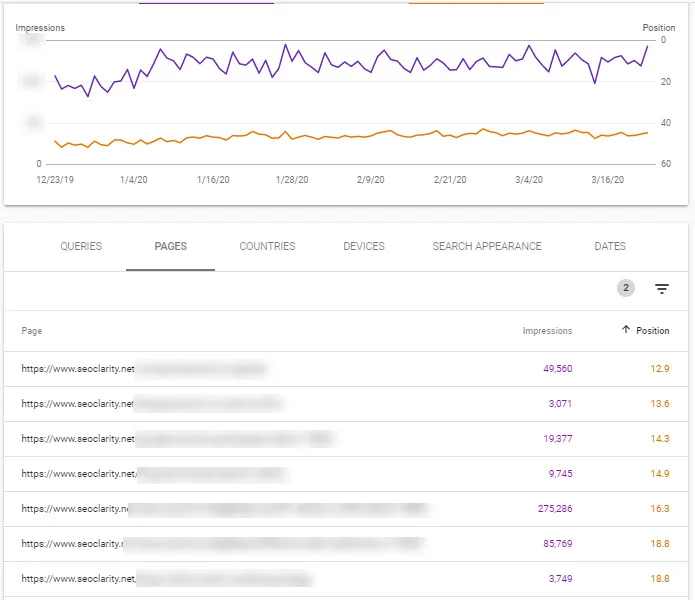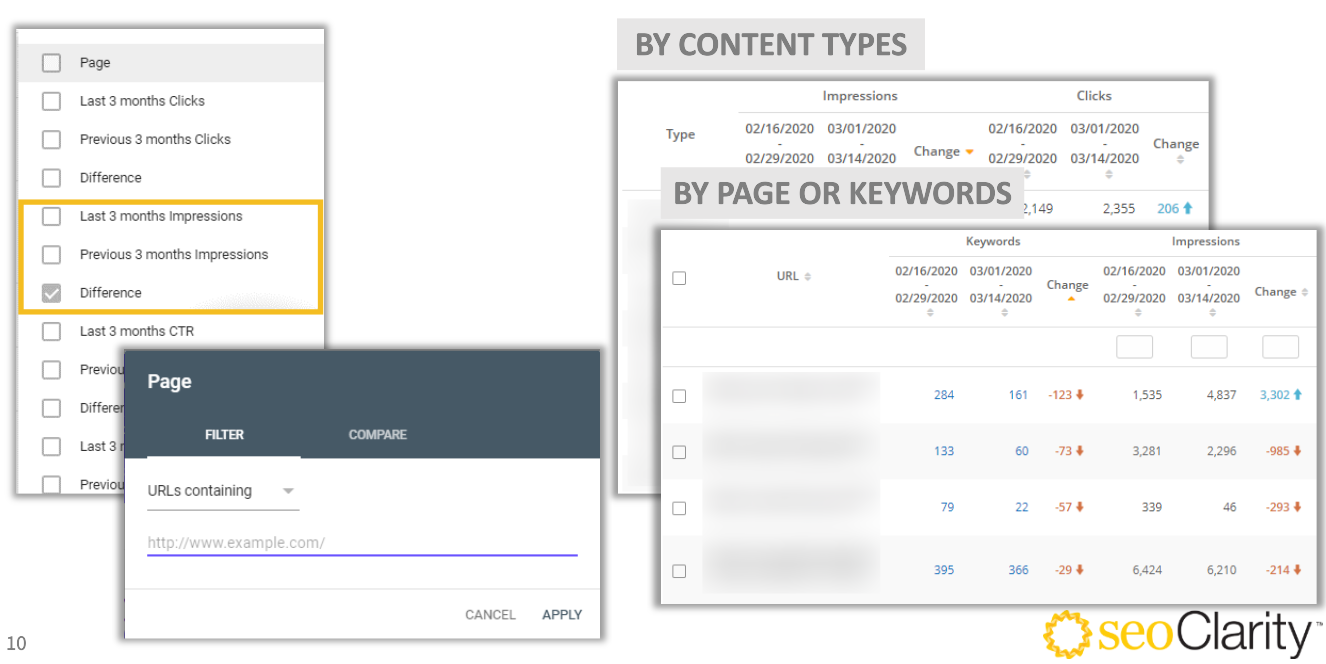Show me the money:
Driving ROI in SEO in Challenging Times


Budget cuts, staff reduction, and a focus on essential spending are all part of the new lexicon surrounding the idea of what “normal” looks like for businesses in the wake of the COVID-19 pandemic.
Executives want to know exactly how to keep costs in check and continue to drive revenue, especially when economic times are turbulent and discretionary spending is carefully monitored.
How can businesses execute and drive results with the resources they currently have?
If you’re an SEO for an enterprise brand, you know first-hand that it’s not always the massive, costly projects that drive results. As a matter of fact, it’s usually the “quick wins” or low-hanging fruit opportunities that offer the most value!
When spending is audited and non-critical operations are cut, it’s important to focus the opportunities that drive results to prove to leadership the revenue opportunities that exist within SEO. Your search visibility is the driving force that allows your business to continue to successfully serve customers, which increases overall reputation, reach and, ultimately conversions.
In this expert-contributed guide for our SMX Next attendees, you can expect to learn:
The following guide walks through the exact, actionable approach and processes to follow to prove to your executives the potential for quick return on SEO investment when they say, “Show me the money!”
No matter your industry or business type, it’s imperative to start with a solid foundation before attempting to build up your success - whether you’re returning to business operations after COVID-19 or just beginning to venture into new business verticals.
With over 20 years of SEO experience under his belt, digital marketing expert Nakul Goyal offers his fundamental approach to your SEO playbook in his presentation below:
The following examples must be included as priorities in your SEO playbook to advance your SEO growth in this “new normal”:
1. Title Tags. Crawl your site to make sure you have unique title tags for every page on your site.
Recommended Reading: How to Write Optimized Page Title Tags
2. Internal Links. Ask yourself: Can both humans and search engines navigate to your site easily? Your pages can only rank if they are findable to your target audience and Googlebot.
Recommended Reading: Internal Links Workflow: How to Optimize and Gain More Site Authority
3. Self-canonical Tag. Conduct a site crawl to determine that you have not created any duplicate pages that plagues your site.
Recommended Reading: What’s the Best Route for Duplicate Content?
4. XML Sitemaps. Submit these to respective search engines that cover all your site’s pages.
Recommended Reading: How to Create a Sitemap and Submit to Google
5. Reciprocal HREFLang tag. This is particularly important for international brands so that search engines know where to send users on your site.
Recommended Reading: 12 Common Hreflang Mistakes and How to Prevent Them
With these foundational but simple steps to address the basics, ensure that your house is in order to make way for incremental growth in your SEO success. Our SEO platform includes site audits with unlimited crawled pages and projects that will help you discover opportunities at scale.
Old and outdated content that isn’t relevant to your user can actually hurt your overall site health, especially when your pages are no longer driving notable organic traffic.
Which brings us to a pop-quiz:
What can you do when your content sees a natural decay? Should you:
A) update it to revive it,
B) create new content to re-approach rankings, or
C) all of the above?
If you answered C, you are correct - all of the above options are possible solutions to solving the content chaos problem! But, before you go plugging content holes and creating even more chaos down the line, you must prioritize what content should be removed and what content should receive an update on your site.
Once you decide on what content needs to be updated, you then need to refresh the content with relevant and purposeful content that provides value to your audience.
Digital marketing expert Claye Stokes, an SEO with 12 years of enterprise experience, offers his approach to content decay featured in his presentation above outlining the steps to take that apply less resources and can drive quick results.
Your first step in refreshing your existing content is prioritizing what to update. This small step is a tremendous help in outlining what to tackle first, making the task at hand more manageable for you or your team.
Inside your rank tracking tool, collect all of the competing URLs in your SERPs and run those URLs through your crawler tool. Use the date modified value in the source code to see when the piece of content was last updated.
Here's the regex pattern that proved helpful for Claye in most common date formats he's run across:
dateModified\"\:(?:.\"|\")([0-9-]{10}|[0-9\s,a-zA-Z]*)
We also recommend using Google Search Console and Google Analytics to determine which content can use a refresh. This process requires no additional investment other than the tools that you already have at your disposal!
GSC shows content and pages on your site that are just within reach of ranking well but never made it onto page one and require minimal optimization effort. Look at content that has slipped from high rankings to the second or third page of Google (rank positions 11-40).

Alternatively, you can use an SEO platform to perform these tasks at scale. seoClarity integrates with Google Search Console data providing users with the ability to filter by page, content types, device, keywords, and more.
To learn our exact process within seoClarity, read our post on how to refresh old content with seoClarity using Content Fusion for content optimization and analysis.
seoClarity offers a free Chrome extension to get page by page insights and suggestions for what each page is relevant for. Download our free content optimizer, Spark.
The pandemic has caused global uncertainty in a lot of industries. With such volatility, how can your business do more than just survive the current market environment and actually find ways to prosper?
The answer lies in providing the products and services that are in higher demand now and are looking to sustain in this current climate of business.
One way to easily determine this from an SEO perspective is to follow a simple, but effective, process, as outlined by SEO legend, Eric Enge:
1. Simply talk to your customers and ask them how their needs have changed. Make a plan to adapt or adjust what you are offering based on their feedback. Leverage social media or customer reviews - however you currently communicate with customers is the best way to approach this task.
2. Do some research on what is driving users to your site. Find these potential opportunities based on content from your own site. Using Google Search Console, locate pages to determine higher demand opportunities that weren’t there before and are currently driving traffic based on the current market landscape. seoClarity integrates GSC data and offers trend charts to easily see the keywords and pages receiving increased traffic.
In an example we’ve seen with some of our clients, let’s say a beer or liquor brand creates content for a virtual happy hour and in turn see an increased demand or low-hanging fruit opportunities driving traffic to their site. It would be prudent to create a new page of happy hour content or update previously existing happy hour content to cover the virtual aspect of happy hours in the wake of COVID-19.
This use case exists in nearly every industry! Finance brands should consider loan and mortgage services pages to answer the demand in that industry that’s sure to persist. Home delivery is another service that has become more applicable across multiple industries facing the “new normal” Which leads us to our next step…
3. Use Google Trends to find demand opportunities related to your search queries to see how your target audience trends have changed. In evaluating these shifts, marketers make inferences about where to switch gears based on what users are currently searching (and may continue searching in the current market).
At seoClarity, we integrated Google Trends data within the platform for a rolling 90 days to help our clients scale by making it extremely easy to identify the aforementioned opportunities they wouldn't have previously considered for their site.
4. Take what you’ve learned from your research and update your site content to reflect what your users are looking for right now as well as what they will be searching for in the weeks, months and years ahead as our consumers continue to adjust their buying behaviors.
Focusing on the latest demand in the market and following the audience-driven trends could be the key to driving your business toward success in our “new normal”.
Recommended Reading: How to Determine Valuable SEO Insights in the Wake of the Coronavirus
Click For More Information: Perficient and their digital marketing and SEO services >
Whether you’re a seasoned SEO veteran or an optimization newbie, you know that there are challenges associated with improving your site’s search visibility. Luckily, there is a way to maximize your success without sacrificing your time and energy and using the quick tools you have readily available.
This four step process from 16-year SEO veteran and SEO powerhouse, Catfish Comstock, may be the key to ensuring you have a technically-sound site that meets your users’ needs.
Looking for a longer, more thorough site audit process? Check out our 16-step SEO audit checklist and this pocket checklist to boost your search visibility and rankings.
Start with image optimization to improve your page speed. Use PageSpeed insights to identify what images have the highest potential or are the largest and in most need of optimization. Then, refer to a tool like Squoosh from Google Chrome Labs to quickly compress or adjust the size of those images and improve your page speed.
Recommended Reading: Your Quick Guide to Page Speed Success
Implement schema across your site for anything and everything that is applicable to structured data from Google. Catfish recommends prioritize schema in the following order, starting with the most important and most impactful pages leveraging these types:
The above should be implemented as a minimum on your site but ultimately, we recommend baking this into your SOPs. For more information on the history of schema, and why it’s imperative to implement, check out our latest webinar on technical best practices for structured data.
Want to get started and implement Schema on your site without developers? We’ve made it super easy with our new Schema Builder Google Chrome plugin that generates JSON-LD code with a point and click interface that anyone in your organization can use.
Actionable Tip: In the time it takes you to read this quick guide, you can find your top trafficked pages that have page one rankings and look for what schema opportunity is available. Leveraging the free Schema Builder tool, create code and drop on the page. Additionally, you can use Google Tag Manager to drop the code into the page and complete this process without an IT project.
Recommended Reading: Schema Markup Generator: Implement Structured Data Without Developers
By reducing the number of clicks to your content, you are making it easier for users and search engines to index your site.
First, create an HTML sitemap for ease of navigation. Then, increase your internal link connectivity so that navigation is clear and concise so that users can find content in a way that makes sense to them. Remove the barriers to what they’re searching for - you want them to find what you’re offering don’t you?
As an additional step, include links in your PDF documents. The additional link connectivity throughout your site will boost other signals as well as enhance your findability by users and engines.
We know this is important based on John Mueller’s 2018 revelation that “more weight is given to pages in search results based on how many clicks it takes to get to them from a site’s home page versus the URL structure” (via Matt Southern for Search Engine Journal).
Is Google processing your tags as you intended? Canonical tags should represent absolute URLs for your site.
Using Google Search Console, identify how Google is treating your canonical tags. GSC sees these tags as signals, not directives, so, if you have an error in your tags or your tags are inconsistent, Google will not be able to index both and may end up indexing the page with errors.
A simple report in GSC tells you where your set of links is inconsistent and your signals are incorrectly aligned.
Recommended Reading: 301 Redirects vs. Rel=Canonical Tags: The Best Route for Duplicate Content
This quick technical SEO audit may be the key to ensuring you have a technically-sound site that meets your users’ needs. But, if you’re interested in unlocking more information about your overall site health, access a FREE site audit and site health report from our team at seoClarity!
Through our unlimited crawl capabilities, this assessment recognizes any issues and is custom to whatever pace, depth, and frequency you require - giving you the power to create a technically-sound and error-free site to provide your customers with the best user experience.
Many enterprise brands currently have the opportunity to get a better positioning in the SERP as well as better traffic to their site with the current resources and tools that are already at their disposal.
One such tool that exists isn’t actually a tool at all, but instead a process that is so simple, regardless of SEO expertise... Title Rewrite Analysis.
The problem occurs when the title that you want and the title that appears in the SERP are different. It may sound surprising, but our research shows that out of the top 5 ranking URLs across 50,000 keywords, nearly one out of every four URLs had rewritten titles.
Why is this happening? There are a multitude of likely reasons, such as:
For the sake of this quick process, Mitul Gandhi, our Chief Product Architect & Co-founder, focuses on title length as this is the top reason we found for page title rewrites. Titles that fell outside of the 20 - 60 character boundary saw a greater chance of being rewritten by Google. While that’s not to say that 20 - 60 characters is a magical number to improve your SEO, data shows that falling within the character limit saw the lowest chance of a title being rewritten.
So, how can you tackle this challenge and take back control of your intended page titles? It’s easy with these simple steps:
Where Google is changing the titles, focus on the areas that stand out where there is a discrepancy between what you have as a page title and what Google tells users your page is titled. It’s fairly easy to identify these patterns when you sort your data by keyword or by title where there is not a match.
Recommended Reading: Conducting a Page Title Rewrite Analysis
If you’re ready for a full integrated SEO platform that includes all SEO capabilities for enterprise scale - we have that, too. For businesses in need of site audits and analytics as well as link management, our full SEO platform provides all SEO data, metrics and capabilities without limitations to do SEO at scale. View our additional packages available and schedule a time to chat to see a demo with our team when it's convenient for you.
Many enterprise SEOs deal with thousands of site visitors each day, searching for products and services with changing demand in the wake of this massive global event.
By understanding the changes of online search behavior, you also begin to understand the true human behavior of those searchers, further supporting your need for SEO in today’s business landscape. This information alone should be enough to prove the exact potential of your SEO program in driving future success.
With access to tools that help you understand search and user behavior, you are in a unique position to see the true global impact of this pandemic and understand how these changes affect (and will continue to affect) your users’ bottom line.
At seoClarity it’s our job to help you to move forward, and we hope the quick and actionable processes outlined above brings you back on track toward ultimate success in SEO and business overall.
The following is a list of tools mentioned by our panel of experts. You’ll want to gather these tools to navigate you toward SEO success.
For more SEO tools you can use in the above workflows, check out our guide to free SEO tools or visit the recommended reading resources in each section.
 Nakul Goyal has more than 20 years of SEO experience, in both the agency and in-house setting. He is currently the Head of Consumer Marketing at CARFAX.COM.
Nakul Goyal has more than 20 years of SEO experience, in both the agency and in-house setting. He is currently the Head of Consumer Marketing at CARFAX.COM.
You can find Nakul on Twitter at @NakulGoyal.
 As the Vice President of Red Ventures, Claye Stokes is an enterprise SEO expert with more than 12 years of SEO and digital marketing experience. Red Ventures is a growing portfolio of world-class digital brands.
As the Vice President of Red Ventures, Claye Stokes is an enterprise SEO expert with more than 12 years of SEO and digital marketing experience. Red Ventures is a growing portfolio of world-class digital brands.
You can find Claye on Twitter at @Claye.
 Eric Enge is currently the Principal for Digital Marketing Solutions BU at Perficient. Previously, he was the founder and CEO of Stone Temple, an award-winning digital marketing agency that was acquired by Perficient in 2018.
Eric Enge is currently the Principal for Digital Marketing Solutions BU at Perficient. Previously, he was the founder and CEO of Stone Temple, an award-winning digital marketing agency that was acquired by Perficient in 2018.
You can find Eric on Twitter at @StoneTemple
 Catfish Comstock has a proven track record of success within a variety of industries and verticals while specializing in B2B tech. With more than 22 years of SEO experience, he now acts as the Director of Search for BusinessOnline.
Catfish Comstock has a proven track record of success within a variety of industries and verticals while specializing in B2B tech. With more than 22 years of SEO experience, he now acts as the Director of Search for BusinessOnline.
You can find Catfish on Twitter at @SEOCatfish.
 Mitul Gandhi is the Chief Product Architect and Co-Founder of seoClarity. He is a data-driven information architect and SEO veteran with more than 20 years experience in digital and ecommerce marketing.
Mitul Gandhi is the Chief Product Architect and Co-Founder of seoClarity. He is a data-driven information architect and SEO veteran with more than 20 years experience in digital and ecommerce marketing.
You can find Mitul on Twitter at @mgandhi.
 Mark Traphagen has worked with some of the top agencies in the industry over his 15 years in the SEO business. He is now the VP of Training and Product Marketing at seoClarty.
Mark Traphagen has worked with some of the top agencies in the industry over his 15 years in the SEO business. He is now the VP of Training and Product Marketing at seoClarty.
You can find Mark on Twitter at @marktraphagen.